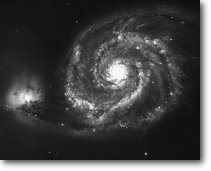|
The
Whirlpool Galaxy
The
@stro object for the week of 04/24/2000
 |
|
image
courtesy of SEDS
|
The Whirlpool
Galaxy. The
Whirlpool Galaxy, cataloged as M51 and NGC 5194, was first discovered
by Charles Messier on October 13th, 1773 while he was observing
a comet. The smaller companion galaxy, located to the left of the
larger Whirlpool in the image, was first discovered by Pierre Mechain
in 1781 and has been cataloged as NGC 5195.
The Whirlpool
is a large spiral galaxy like our own Milky Way galaxy. It was the
first galaxy to be observed and identified to have spiral arms.
Astronomers theorize that M51's spiral arms may actually be the
result of gravitational interaction with its smaller companion galaxy.
The Whirlpool
galaxy is one of the brightest galaxies in the night sky and is
easily visible with modest telescopes in dark skies. However, it
can be washed out by light-pollution and may be difficult to observe
in urban skies.
| Current
information for the Whirlpool Galaxy (Northern Hemisphere): |
| Rise: 13:06
|
| Transit:
23h 14m |
| Set: 09:26
|
| Magnitude:
~8.4 |
| Constellation:
Canes Venatici |
| Distance:
Estimates vary between 15 to 37 million light-years |
For more
information visit:
APOD of the Whirlpool Galaxy...
SEDS
webpage on the Whirlpool Galaxy...
Whirlpool
Galaxy nucleus from the HST...
|